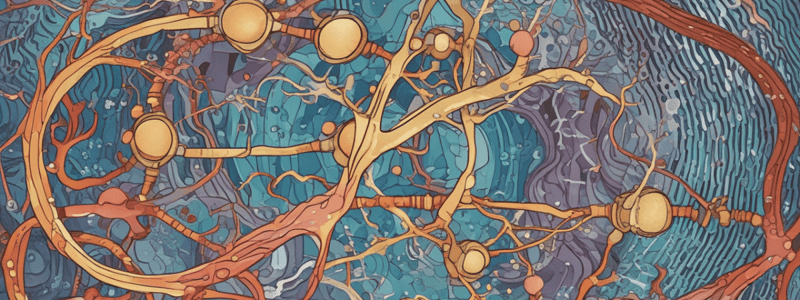Podcast
Questions and Answers
What is the sequence of steps in the signaling complex, including inhibitory steps?
What is the sequence of steps in the signaling complex, including inhibitory steps?
- A sequence of five steps, including three inhibitory steps
- A sequence of two steps, including one inhibitory step
- A sequence of three steps, including one activating step
- A sequence of four steps, including two sequential inhibitory steps that are equivalent to a single activating step (correct)
How is the signaling complex assembled on the receptor?
How is the signaling complex assembled on the receptor?
- By the activation of intracellular signaling proteins
- By a large scaffold protein (correct)
- By the phosphorylation of the receptor
- By the binding of an extracellular signal molecule
What happens to the receptor after the binding of an extracellular signal molecule?
What happens to the receptor after the binding of an extracellular signal molecule?
- It is activated by the binding of an intracellular signaling protein
- It is phosphorylated at multiple sites (correct)
- It is internalized by the cell
- It is degraded by the cell
What is the role of phosphoinositides in the signaling complex?
What is the role of phosphoinositides in the signaling complex?
What type of interaction domains are found in signaling proteins?
What type of interaction domains are found in signaling proteins?
How does the response timing vary in different signaling systems?
How does the response timing vary in different signaling systems?
How do hormones and neurotransmitters differ in their sensitivity to extracellular signals?
How do hormones and neurotransmitters differ in their sensitivity to extracellular signals?
What is the role of the scaffold protein in the signaling complex?
What is the role of the scaffold protein in the signaling complex?
What is the origin of the term 'hormone'?
What is the origin of the term 'hormone'?
How are hormones named?
How are hormones named?
What type of signaling involves ligands targeting cells only in the vicinity of the original emitting cell?
What type of signaling involves ligands targeting cells only in the vicinity of the original emitting cell?
What type of signaling involves ligands produced by the target cell binding to a receptor within the cell?
What type of signaling involves ligands produced by the target cell binding to a receptor within the cell?
What is a mechanism for increasing the sensitivity of a signaling system?
What is a mechanism for increasing the sensitivity of a signaling system?
What is the result of a cell being deprived of appropriate survival signals?
What is the result of a cell being deprived of appropriate survival signals?
What is the dynamic range of a signaling system related to?
What is the dynamic range of a signaling system related to?
What is true about the receptors on a cell?
What is true about the receptors on a cell?
What is necessary for a cell to survive?
What is necessary for a cell to survive?
What is a characteristic of a signaling system that can respond over a narrow range of extracellular signal concentrations?
What is a characteristic of a signaling system that can respond over a narrow range of extracellular signal concentrations?
What is a way to convert a simple signal into a complex response?
What is a way to convert a simple signal into a complex response?
What type of signaling involves ligands targeting distant cells and often traveling through the circulatory system?
What type of signaling involves ligands targeting distant cells and often traveling through the circulatory system?
What is the role of feedback in biochemical switches and oscillators?
What is the role of feedback in biochemical switches and oscillators?
What allows a response to be governed by multiple inputs?
What allows a response to be governed by multiple inputs?
How can coordination of multiple responses in one cell be achieved?
How can coordination of multiple responses in one cell be achieved?
What is an example of a signaling pathway?
What is an example of a signaling pathway?
What is the role of Protein B in the mechanism described?
What is the role of Protein B in the mechanism described?
What post-translational modifications are often involved in the mechanisms operating at the level of the receptor?
What post-translational modifications are often involved in the mechanisms operating at the level of the receptor?
What is the purpose of alternative splicing of mRNA for hormones?
What is the purpose of alternative splicing of mRNA for hormones?
What is the location where the processing of precursor proteins takes place?
What is the location where the processing of precursor proteins takes place?
What is the function of the ligand-binding domain in hormone receptors?
What is the function of the ligand-binding domain in hormone receptors?
What is the role of the P-box in the zinc finger?
What is the role of the P-box in the zinc finger?
What is the function of the D-box in the zinc finger?
What is the function of the D-box in the zinc finger?
What causes the formation of a loop in the zinc finger?
What causes the formation of a loop in the zinc finger?
What is the result of phospholipase C cleavage of phosphatidyl inositol 4,5-bisphosphonate?
What is the result of phospholipase C cleavage of phosphatidyl inositol 4,5-bisphosphonate?
What is the function of basal cells in olfactory epithelium?
What is the function of basal cells in olfactory epithelium?
What is the structure that extends from the surface of most vertebrate cells and serves as a signaling organelle?
What is the structure that extends from the surface of most vertebrate cells and serves as a signaling organelle?
What is the location of olfactory receptors and signal transduction machinery?
What is the location of olfactory receptors and signal transduction machinery?
What is the function of olfactory receptor neurons?
What is the function of olfactory receptor neurons?
How many discs are present in the outer segment of a photoreceptor cell?
How many discs are present in the outer segment of a photoreceptor cell?
What is the connection between the disc membranes and the plasma membrane in photoreceptor cells?
What is the connection between the disc membranes and the plasma membrane in photoreceptor cells?
What is the function of GPCRs mentioned in the content?
What is the function of GPCRs mentioned in the content?
Flashcards are hidden until you start studying
Study Notes
Hormones and Cell Signaling
- The term "hormone" comes from the Greek word "hermon", meaning "to excite or set into motion".
- Hormones are chemicals produced in one area of the body that have an effect on another area.
- Hormones are named based on their effect on the body, not their location of production.
Types of Hormone Signaling
- Autocrine signaling: ligands function internally and on other target cells.
- Paracrine signaling: ligands target cells only in the vicinity of the original emitting cell.
- Endocrine signaling: hormones that target distant cells and often travel through the circulatory system.
- Intracrine signaling: ligands are produced by the target cell and bind to a receptor within the cell.
- Juxtacrine signaling: ligands target adjacent cells.
Cell Signaling Mechanisms
- Each cell type displays a set of receptors that enable it to respond to a set of signal molecules.
- An individual cell often requires multiple signals to survive, grow, and differentiate.
- If deprived of appropriate survival signals, a cell will undergo apoptosis (cell suicide).
Receptor Signaling
- A receptor and some intracellular signaling proteins are preassembled into a signaling complex on the inactive receptor.
- The activated receptor phosphorylates itself at multiple sites, which then act as docking sites for intracellular signaling proteins.
- Activation of a receptor leads to the increased phosphorylation of specific phospholipids in the adjacent plasma membrane.
Intracellular Signaling Proteins
- Types of interaction domains in signaling proteins:
- Src homology 2 (SH2) domains
- Phosphotyrosine-binding (PTB) domains
- Src homology 3 (SH3) domains
- Pleckstrin homology (PH) domains
Signaling Systems
- Response timing varies in different signaling systems, according to the speed required for the response.
- Sensitivity to extracellular signals varies greatly, with hormones acting at very low concentrations on distant target cells.
- Signal amplification is a mechanism for increasing the sensitivity of a signaling system.
- Dynamic range of a signaling system is related to its sensitivity, with some systems responding over a narrow range of extracellular signal concentrations and others over a broader range.
Signal Processing
- Signal processing can convert a simple signal into a complex response, such as an abrupt, switch-like response or an oscillatory response.
- Feedback lies at the heart of biochemical switches and oscillators.
- Integration allows a response to be governed by multiple inputs.
Coordination of Multiple Responses
- Coordination of multiple responses in one cell can be achieved by a single extracellular signal.
- Coordination depends on mechanisms for distributing a signal to multiple effectors, including branches in the signaling pathway.
Hormone Synthesis and Processing
- Many protein and peptide hormones are synthesized within a larger precursor protein.
- The process is catalyzed by specific proteases that cleave the protein at specific sites.
- Alternative splicing of mRNA for hormones can also occur.
Receptor Structure
- A receptor typically consists of a ligand-binding domain that noncovalently binds the correct hormone and an effector domain that responds to the presence of the hormone bound to the ligand domain.
Zinc Finger Proteins
- The coordination of a Zn2+ atom by four cysteines causes the formation of a loop in zinc finger proteins.
- The P-box in the first zinc finger is involved in binding to specific DNA binding sites and discriminating between closely related sites for different hormones.
G Proteins and Ion Channels
- Smell and vision depend on GPCRs that regulate ion channels.
- Olfactory receptor neurons possess modified cilia that contain the olfactory receptors and the signal transduction machinery.
- The axon of the receptor neuron conveys electrical signals to the brain when an odorant activates the cell to produce an action potential.
Studying That Suits You
Use AI to generate personalized quizzes and flashcards to suit your learning preferences.




